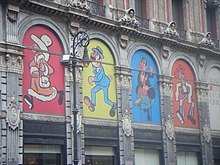Mexican comics
| Mexican comics | |
|---|---|

Gabriel Vargas comic characters from La Familia Burrón. Museo del Estanquillo, Mexico City.
|
|
| Creators | Gabriel Vargas |
| Languages | Mexican Spanish |
Comics culture in Mexico is far from being a modern phenomenon. Its roots may be traced back to many stages in Mexican history. Indeed, Mexican intellectuals such as Ilan Stavans agree that pre-Columbian codices and other ancient documents could be seen as primary sources of the comics culture in the country.
Another important influence has been the work of José Guadalupe Posada whose satirical cartoons helped create a political identity of visual art. Political satire was quite a strong movement in the Porfiriato (1884-1911) and many newspapers became almost legendary because of their political comics.
As a result of government repression, the political cartoon ("caricatura política") practically became the only means of free expression in those turbulent years.
Later, there would be a national industry for many decades with great authors like Yolanda Vargas Dulché (founder of Grupo Editorial Vid), starring titles like Memín Pinguín, La Familia Burrón and Chanoc among many others.
From the 1930s through the 1970s, Mexico had a thriving comic-book industry with many and diverse genres. Authors and artists like Gabriel Vargas, Germán Butze, Gaspar Bolaños, Oscar González Guerrero, José Angel Mora Suarez and Rius became famous with very original and diverse comic book series and titles such as Los Superlocos, La Familia Burrón, Adelita y Juan Sin Miedo, Pancho López, El Gran Caperuzo, Los Chiflados, Los del Doce, Sopa de Perico, Chanoc, Pepín, Fantomas, Kalimán, Rolando el Rabioso, El Payo, Hermelinda Linda, Los Supersabios, Los Supermachos, Los Agachados, Las Aventuras del Santo, Tinieblas, Blue Demon, El Tío Porfírio, Burrerías, Smog, Don Leocadio, Zor y los Invencibles, Las Aventuras de Capulina, Las Aventuras de Cepillín, El Monje Loco and Memín Penguín to name a few.
...
Wikipedia
